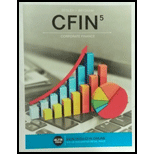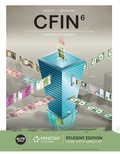
CFIN
5th Edition
ISBN: 9781305661639
Author: Scott Besley, Eugene Brigham
Publisher: Cengage Learning
expand_more
expand_more
format_list_bulleted
Question
Chapter 5, Problem 4PROB
Summary Introduction
The rate of
W sold each share for $156 which is purchased one year ago at $150 each.
Expert Solution & Answer
Want to see the full answer?
Check out a sample textbook solution
Students have asked these similar questions
what is financial ratios?
Which of the following is the activity which finance people are involved?
(a) Investing decisions
(b) Marketing decisions
(c) Promotion decisions
(d) Non of Above
You plan to invest $3,500 per year for 39 years into an IRA. What will the value of the IRA be after 39 years if the interest rate is 9% per year? Your answer may vary due to rounding.
Knowledge Booster
Similar questions
- In finance, we refer to the market where new securities are bought and sold for the first time? (a) Money market (b) Capital market (c) Primary market (d) Secondary marketarrow_forward1: ________ is shown on a multiple-step but not on a single-step income statement. A. Credited to Inventory B. A customer utilizes a prompt payment incentive. C. Debited to the Inventory account D. Gross profitarrow_forwardwhat is corporate finance? explain it.arrow_forward
- A lorenz curve graphs the _________________ received by everyone up to a certain quintile. A. Unequal distribution over time B. Normative shares of income C. Cumulative shares of income D. Total share of incomearrow_forwardNeedhdjxjx ususs shsharrow_forwardCalculate dividends for this question i need help.arrow_forward
- Please no spreadsheet workings.arrow_forwardQuestion 5 1 The common shares of Almond Beach Inc, have a beta of 0.75, offer a return of 9%, and have an historical standard deviation of return of 17%. Alternatively, the common shares of Palm Beach Inc. have a beta of 1.25, offer a return of 10%, and have an historical standard deviation of return of 13%. Both firms have a marginal tax rate of 37%. The risk-free rate of return is 3% and the expected rate of return on the market portfolio is 9½%%. 1. Which company would a well-diversified investor prefer to invest in? Explain why and show all calculations. 2. Which company Would an investor who can invest in the shares of only one firm prefer to invest in? Explain why. Use the following template to organize and present your results: Theoretical CAPM Actual offered Almond Beach Inc. Palm Beach Inc. prediction for expected return (%) return (%) Standard deviation of return (%) Beta Comments on the diversified investor's choice Comments on the individual investor's choicearrow_forwardsolve this question by using appropriate methodology and true answer.arrow_forward
arrow_back_ios
SEE MORE QUESTIONS
arrow_forward_ios
Recommended textbooks for you





